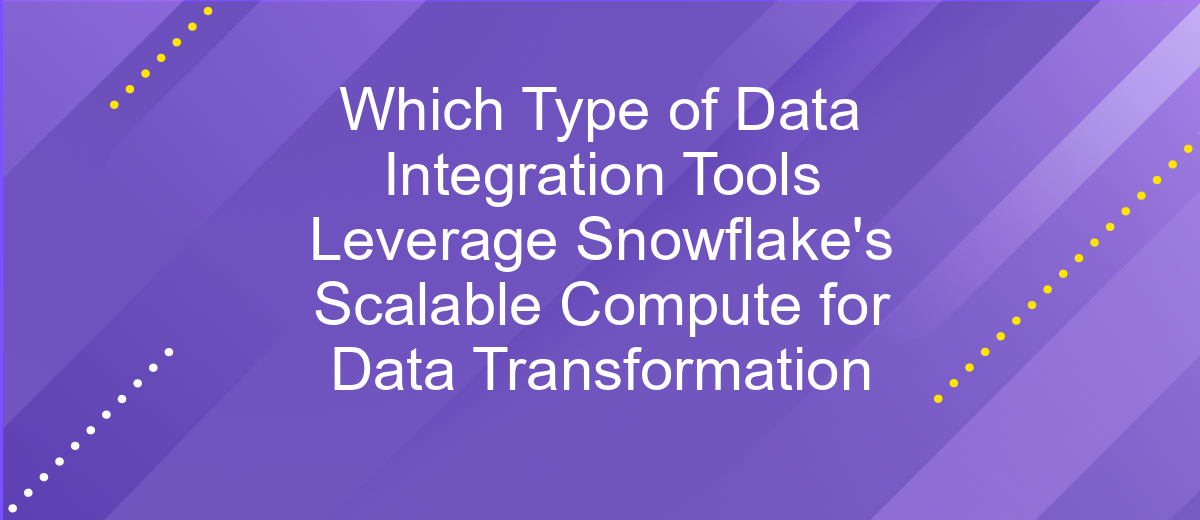Which Type of Data Integration Tools Leverage Snowflake's Scalable Compute for Data Transformation
In today's data-driven landscape, leveraging scalable compute for efficient data transformation is crucial. Snowflake, a leading cloud data platform, offers robust capabilities for this purpose. This article explores various data integration tools that maximize Snowflake's scalable compute, enabling seamless data transformation. Discover which tools best harness Snowflake's power to streamline your data workflows and enhance analytical insights.
Introduction
In today's data-driven world, businesses are inundated with vast amounts of data from diverse sources. Efficiently integrating and transforming this data is crucial for gaining actionable insights and maintaining a competitive edge. Snowflake's cloud data platform offers scalable compute capabilities, making it an ideal choice for data transformation tasks. However, selecting the right data integration tools that can leverage Snowflake's power is essential for optimizing performance and achieving seamless data workflows.
- ETL (Extract, Transform, Load) Tools
- ELT (Extract, Load, Transform) Tools
- Data Orchestration Tools
- Data Virtualization Tools
Each of these tools has its own strengths and use cases, and understanding their capabilities in the context of Snowflake's architecture can significantly impact the efficiency of data operations. This article explores various types of data integration tools that can harness Snowflake's scalable compute for effective data transformation, providing insights into their functionalities and advantages.
Snowflake's Scalable Compute

Snowflake's scalable compute architecture is designed to handle diverse data workloads with ease, providing unparalleled flexibility and performance. By separating storage and compute, Snowflake allows users to scale their resources independently, ensuring that they only pay for what they use. This model is particularly beneficial for data transformation tasks, where computational demands can vary significantly. Snowflake's virtual warehouses can be resized on-the-fly, enabling seamless scaling to meet the needs of any data integration process without downtime.
Leveraging Snowflake's capabilities, tools like ApiX-Drive can efficiently manage data integration and transformation workflows. ApiX-Drive offers a user-friendly interface for setting up integrations between various applications and Snowflake. It automates data transfers and transformations, ensuring that data is always up-to-date and readily available for analysis. By utilizing Snowflake's scalable compute, ApiX-Drive can handle large volumes of data and complex transformation tasks, providing businesses with a robust solution for their data integration needs.
Types of Data Integration Tools

Data integration tools are essential for combining data from various sources into a unified view. These tools enable organizations to streamline workflows, improve data quality, and facilitate better decision-making. Snowflake, with its scalable compute power, enhances the efficiency and speed of data transformations performed by these tools.
- ETL (Extract, Transform, Load) Tools: These tools extract data from different sources, transform it into a suitable format, and load it into a target database or data warehouse.
- ELT (Extract, Load, Transform) Tools: Unlike ETL, these tools load raw data into the target system first and then perform transformations, leveraging Snowflake's compute capabilities.
- Data Replication Tools: These tools copy data from one database to another, ensuring consistency and synchronization across systems.
- Data Virtualization Tools: These tools create a virtual layer that allows users to access and query data from multiple sources without physical data movement.
- iPaaS (Integration Platform as a Service) Tools: Cloud-based platforms that integrate various applications and services, enabling seamless data flow across different environments.
Choosing the right data integration tool depends on your specific needs, data sources, and the complexity of transformations required. Leveraging Snowflake's scalable compute ensures that these tools operate efficiently, delivering timely and accurate data for business intelligence and analytics.
Tools That Leverage Snowflake's Scalable Compute

Snowflake's scalable compute capabilities make it an ideal platform for data transformation, and several tools have been optimized to leverage this power. These tools enable organizations to handle large volumes of data efficiently, ensuring seamless and rapid transformations.
Among the most notable tools are those that integrate directly with Snowflake, providing robust data transformation functionalities. These tools not only enhance the performance but also simplify the process of managing and transforming data within Snowflake's environment.
- Matillion: A cloud-native ETL tool that integrates seamlessly with Snowflake, offering a range of transformation capabilities.
- Talend: Known for its extensive data integration features, Talend provides strong support for Snowflake's scalable compute.
- Fivetran: Automates data integration with Snowflake, ensuring real-time data transformation and synchronization.
- Alteryx: Combines data preparation, blending, and analytics with Snowflake's powerful compute engine.
These tools not only leverage Snowflake's scalable compute but also provide a user-friendly interface and advanced features that cater to various data transformation needs. By integrating with Snowflake, they enable organizations to maximize their data potential and drive more informed business decisions.


Benefits of Leveraging Snowflake's Scalable Compute
Leveraging Snowflake's scalable compute for data transformation offers numerous benefits that significantly enhance data processing capabilities. One of the primary advantages is the ability to handle large volumes of data with ease, ensuring that even complex transformations are performed efficiently. This scalability allows businesses to process and analyze data in real-time, leading to faster decision-making and improved operational efficiency. Additionally, Snowflake's architecture separates storage from compute, enabling users to scale resources independently based on their specific needs, optimizing costs and performance.
Another significant benefit is the seamless integration capabilities with various data tools and platforms. For instance, services like ApiX-Drive facilitate the integration process by providing automated workflows and connectors that simplify data movement and transformation tasks. This ensures that data from multiple sources can be aggregated, transformed, and analyzed without extensive manual intervention. By leveraging Snowflake's scalable compute in conjunction with integration tools like ApiX-Drive, organizations can streamline their data pipelines, reduce latency, and achieve a more robust and agile data infrastructure.
FAQ
What are the key features of data integration tools that leverage Snowflake's scalable compute for data transformation?
How do data integration tools optimize performance when working with Snowflake?
Can these tools handle real-time data integration and transformation?
What are the benefits of using automated data integration tools with Snowflake?
How do data integration tools ensure data quality and consistency when integrating with Snowflake?
Apix-Drive will help optimize business processes, save you from a lot of routine tasks and unnecessary costs for automation, attracting additional specialists. Try setting up a free test connection with ApiX-Drive and see for yourself. Now you have to think about where to invest the freed time and money!

